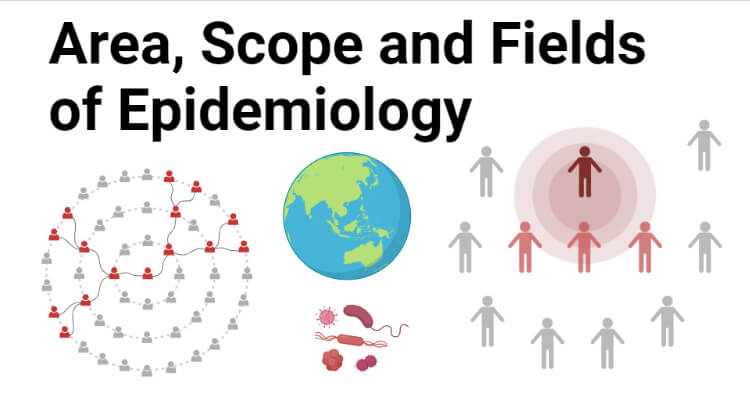- Epidemiology is defined as “the study of the distribution and determinants of health-related states or events in specified populations, and application of this study to control of health problems.”
- Epidemiological studies include observation, surveillance, hypothesis‐testing analytic research methods, and experiments.
- For many years epidemiology was considered to be restricted to the infectious diseases, epidemics, and endemics which were the major health problem in the past.
- With changing pattern of population morbidity and mortality, the scope of epidemiology has been enlarging.
- The scope of epidemiology has been greatly enlarged during the past two decades.
- Lately, epidemiology was extended to endemic communicable diseases and non-communicable infectious diseases.
- Recently, epidemiology can be applied to all diseases and other health-related events.

Interesting Science Videos
Epidemiology as an Interdisciplinary Subject
- As an interdisciplinary field, epidemiology draws from biostatistics and the social and behavioral sciences as well as from the medically related fields such as toxicology, pathology, virology, genetics, microbiology, and clinical medicine.
- Epidemiology is an extraordinarily rich and complex science that derives techniques and methodologies from many disciplines.
- Epidemiology must draw upon and synthesize knowledge from the biological sciences of man and of his parasites, from the numerous sciences of the physical environment, and from the sciences concerned with human society.
Major Areas of Epidemiology
Major areas of epidemiological study include:
- Disease causation
- Disease transmission
- Outbreak investigation
- Disease surveillance
- Screening, biomonitoring, and comparisons of treatment effects such as in clinical trials.
Fields of Epidemiology
- Aging epidemiology: Examines the public health impact of aging societies, and the multifactorial changes associated with aging that make health issues for older persons important and unique.
- Applied public health epidemiology: Areas of focus include population health status assessment; infectious and chronic disease surveillance and control; maternal and child health epidemiology; and environmental health epidemiology.
- Cancer Epidemiology: Cancer epidemiology is the study of the distribution and determinants of the likelihood of cancer development. Cancer epidemiology can be used to identify events that increase or decrease cancer incidence in specific populations.
- Cardiovascular and diabetes epidemiology: It is the study of the distribution and determinants of the likelihood of cardiovascular disease and diabetes development.
- Clinical trials and methods: The activities of the epidemiologic methods group contribute to all areas of emphasis, specializing in design and conduct of studies including adaptive trials, survey sampling, and statistical methods.
- Environmental epidemiology: Environmental epidemiology is a branch of epidemiology concerned with determining how environmental exposures impact human health. This field seeks to understand how various external risk factors may predispose to or protect against disease, illness, injury, developmental abnormalities, or death.
- Global health epidemiology: Global health epidemiology addresses the causes and consequences of morbidity and mortality that cross-regional or national boundaries, with emphasis on research in resource-poor countries and application of research findings to the implementation of programs to promote health in those areas.
- Infectious disease epidemiology: The study of the incidence and spread of infectious diseases in populations over time. Host, pathogen and environmental factors are monitored to determine the dynamics of infection, the ultimate goal of which is to devise intervention strategies.
- Injury prevention epidemiology: Emphasis on the application of epidemiologic methods in population and clinical settings to understand key risk and prognostic factors for primary and secondary prevention of injury.
- Forensic epidemiology: The discipline of forensic epidemiology, a branch of forensic medicine, provides a systematic approach to the assessment of general and specific (individual) causation, with the results suitable for presentation in a court of law.
- Molecular and genetic epidemiology: Molecular epidemiology is a branch of epidemiology and medical science that focuses on the contribution of potential genetic and environmental risk factors, identified at the molecular level, to the etiology, distribution, and prevention of disease within families and across populations. Genetic epidemiology aims to identify the unknown genes that influence risk of malignancies.
- Population neuroscience: Focuses on the application of epidemiology methods and cutting-edge neuroimaging methodologies in population and clinical studies to enhance etiological research and evaluation of specific therapies in the disorders of the central nervous system.
- Occupational epidemiology: Occupational epidemiology is a subdiscipline of epidemiology that focuses on investigations of workers and the workplace.
- Obesity and nutritional epidemiology: The study of nutrition and other behavioral factors and their relation with population health. At the same time, it aims to better understand the dynamics of obesity and other metabolic disorders, studying their determinants and consequences.
- Prevention, lifestyle, and physical activity epidemiology
- Psychiatric epidemiology: The psychiatric epidemiology area of emphasis focuses on the acquisition of epidemiological, biostatistical, and psychiatric concepts and methods, and on their application to research in the field of psychiatric disorders.
- Reproductive, perinatal, and pediatric epidemiology: This area focuses on the determinants of health and disease in reproduction and childhood development.
- Women’s health epidemiology: Women’s health epidemiologists conduct research to improve the physical and mental health, safety and well-being of the maternal and child health.
References
- Vlajinac H. (2008) Epidemiology, Aims and Scope. In: Kirch W. (eds) Encyclopedia of Public Health. Springer, Dordrecht
- Beaglehole, Robert, Bonita, Ruth, Kjellström, Tord & World Health Organization. (1993). Basic epidemiology, Updated reprint. World Health Organization.
- https://ajph.aphapublications.org/doi/pdf/10.2105/AJPH.52.9.1371
- https://www.sciforschenonline.org/journals/epidemiology-public-health/aim-scope.php
- https://www.oxfordscholarship.com/view/10.1093/acprof:oso/9780195300666.001.0001/acprof-9780195300666-chapter-1
- https://www.slideshare.net/tilahunigatu/epidemiology-notes
- https://www.omicsonline.org/aimsandscope-epidemiology-open-access-open-access.php
- https://www.hsph.harvard.edu/epidemiology/areas-of-interest/
- http://www.montefiore.ulg.ac.be/~kvansteen/GeneticEpi-PublicHealth/ac0910/Chapter3/BackgroundReading_CH3b_BonitaGEpiBook.pdf
